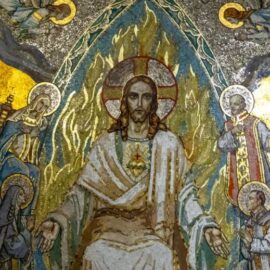

This article is an excerpt from the Shortform summary of "The Case for Christ" by Lee Strobel. Shortform has the world's best summaries of books you should be reading.
Like this article? Sign up for a free trial here .
Were there really 500 witnesses to the resurrection? Is there any evidence of this claim?
In The Case for Christ, Lee Strobel sets out to discover if there really were 500 witnesses to the resurrection. He also looks to see if there’s any proof.
Read more about Strobel’s discoveries about whether or not there were 500 witnesses to the resurrection—and what that means.
500 Witnesses to the Resurrection
Critics of Christianity are eager to point out that, whatever other evidence there might be for the Resurrection, no one actually saw Jesus rise from the dead and leave the tomb.
Scholars like Habermas concede this argument, but they definitely don’t think it means the Resurrection didn’t happen. If Jesus died on the cross—which Dr. Metherell’s account established beyond the shadow of a doubt (see Chapter 11)—then all there’s left to prove is whether Jesus appeared to people after his death. And there’s ample evidence to indicate he did. In the Bible, 500 witnesses to the resurrection claim Jesus rose from the dead.
1 Corinthians
The early church creed featured in 1 Corinthians includes the assertion by Paul that Jesus had not only appeared to him, but to the twelve apostles, 500 of Jesus’s followers, and Jesus’s brother James. There are several reasons why Paul’s testimony is especially convincing:
- Scholars have dated the writing of 1 Corinthians to between 55 and 57 AD, and Paul likely gave the creed to the church at Corinth prior to 51 AD. Which is to say, the creed was being promulgated a mere twenty years after Jesus’s death. (And possibly even earlier: Habermas himself agrees with the minority of scholars who trace the creed to between 32 and 38 AD—within two to three years of the Resurrection.) If early Christians or their critics took issue with Paul’s account, there were plenty of eyewitnesses still living whom they could have questioned.
- Paul was initially a committed skeptic of Jesus. That means that he would have had to have an especially good reason—for example, Jesus’s appearing to him after his death on the cross—to become a believer.
- Paul learned about Jesus’s appearing to the other witnesses when he visited Jerusalem himself. During this trip, Paul interviewed Peter and James in person with the aim of establishing a factual account of the Resurrection (in Galatians 1:18, Paul uses the Greek word historeo—signifying an “investigative inquiry”—to describe his trip to Jerusalem).
- In 1 Corinthians 15:11, Paul states that he’s preaching the same creed as the other apostles. This means that all the apostles, including those like Peter and James that saw Jesus after his death, agreed on the factuality of Jesus’s posthumous appearance.
The Question of the 500
Although the majority of Paul’s account is corroborated elsewhere in the New Testament, one detail he mentions is conspicuously absent from any secular or religious source: the 500 witnesses to whom Jesus allegedly appeared. To some, this unsubstantiated claim destroys Paul’s credibility. But in the Bible, 500 witnesses to the resurrection does seem like it could help explain the resurrection.
One thing to remember is that the creed in 1 Corinthians is the oldest and most widely corroborated passage in the New Testament. Isn’t it just possible that Paul’s account is right where the others are wrong?
In the Bible, the 500 witnesses to the resurrection are written about by Paul. Another key point is that Paul didn’t have to mention the 500 if he didn’t want to. In essence, he was inviting his readers, many of whom would have been contemporaries of the 500 witnesses to the resurrection, to seek them out and ask about Jesus’s return themselves. Why would he invite this kind of scrutiny if he wasn’t sure his account was correct?
The Question of the First Witness
Another discrepancy between Paul’s creed and the gospel accounts concerns the person to whom Jesus first presented himself: in 1 Corinthians, it’s Peter; in John, it’s Mary Magdalene. Don’t these contradictions hurt Paul’s credibility? And what about the 500 witnesses to the resurrection?
They do not, because there may not even be a discrepancy. The creed actually never says that Jesus appeared first to Peter; rather, it says that Jesus appeared to a number of people and simply lists Peter first. That is to say, he might have appeared to Mary Magdalene first, but for contextual or cultural reasons—for example, the inadmissibility of women’s testimony in Jewish law—Paul decided to omit the specific female witnesses.

———End of Preview———
Like what you just read? Read the rest of the world's best summary of Lee Strobel's "The Case for Christ" at Shortform .
Here's what you'll find in our full The Case for Christ summary :
- How an atheist lawyer-journalist researched Christ and began believing
- The key arguments against the existence of Christ, and why they don't hold up
- How to make up your own mind about whether Christ existed







500 witnesses to the risen jesus? How about contemporary witnesses today that saw Bigfoot, lockness monster, ghosts, faith healing, psychic readings, UFO abductions, astrology, ESP, etc. And don’t forget witnesses to other religions(like Allah flying off on a winged horse), etc.
But, the fact remains, Nobody DIED giving their souls to the Bigfoot of your analogy. Jesus lives, I pray the HOLY SPIRIT will draw you.
The Greatest Man in History , He had no servants yet they called him Master , He had no degree yet they called him teacher , He had no medicines yet they called him healer , he had no Army yet all the Kings Feared him , He won no Battles yet He Conquered the World , He Committed no Crimes yet this they crucified him , they buried him in a Tomb yet he still lives Today . His name is Jesus Christ
How about Matthew 27:50-53 where saints rose from their graves on Easter Sunday and walk the holy city for 40 days before ascending into heaven with Jesus?” Not one writer, historian, or philosopher for that time wrote about it. The reason why is that it would call into question the entire event of the resurrection.
“This is one of the strangest passages in the Gospel of Matthew. We don’t know about this event from any other source, and Matthew doesn’t tell us very much. So we really don’t know what this was all about, but apparently these resuscitated saints died once again, because they were raised from the dead in the sense that Lazarus was – not to resurrection life, but to die again.”
i. They were raised, “Not to converse again, as heretofore, with men, but to accompany Christ, that raised them, into heaven; and to be as so many ocular demonstrations of Christ’s quickening power.” (Trapp)
If 100,000 eyewitnesses claimed to see a resurrected corpse, I would not believe them. Here’s why:
https://lutherwasnotbornagaincom.wordpress.com/2023/06/21/if-100000-eyewitnesses-claimed-to-see-the-resurrected-jesus-i-would-still-not-believe/
Isn’t it a big problem that no two Gospels describe the same resurrection appearance? Sure, it is possible that each of these fantastical events occurred, but without corroboration, these stories may also be theological fiction.
Let my give an analogy. Four witnesses claim to have seen the same dead person alive again. However, each witness describes an appearance which could not possibly be the same appearance as described by the other witnesses. One witness says he and some friends saw the dead person in New York on a mountain. One witness says he and some friends saw the dead person on a beach in California. One witness says that he and ten friends saw the dead person in a locked room in Denver, but one friend wasn’t there. The fourth witness says he actually wasn’t even there but someone who was there told him that the same friends saw the dead person in a locked room in Denver but the missing friend WAS there. Sure, each of these dead person appearances could be historical, but since there is no corroboration they could also be the fictitious inventions of each witness. Without corroboration, the veracity of these fantastical stories is highly dubious.